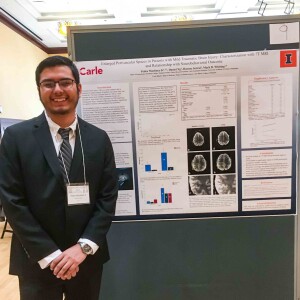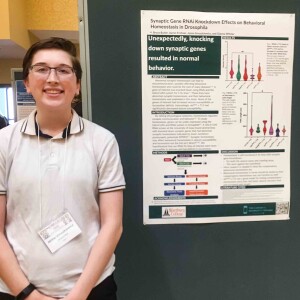Wartburg students present at MidBrains conference
November 4, 2022
Wartburg College students Pedro Martinez and Jenna Smuszkiewicz presented their research at the Midwest Regional Neuroscience Conference (MidBrains) in Eau Claire, Wis., on Oct. 22.
Martinez presented “Enlarged Perivascular Spaces in Patients with Mild Traumatic Brain Injury: Characterization with 7T MRI and Relationship with Neurobehavioral Outcome,” based on research completed this summer at the University of Illinois Urbana-Champaign. Smuszkiewicz presented “Synaptic Gene RNAi Knockdown Effects on Behavioral Homeostasis in Drosophila,” based on research conducted last year at Wartburg with fellow students Bryce Butler, Aaron Frohner and Gianna Witmer while under the supervision ofStephanie Toering Peters, professor of biology.
While at the Carle Foundation Hospital at UI, Martinez analyzed brain scans of patients with mild traumatic brain injuries, otherwise known as concussions, as part of a 90-day study.
“We would utilize these brain images to observe whether there was an impairment to the glymphatic system and whether there would be a development of enlarged perivascular spaces following the injury to the brain,” he said. “This is a relatively new branch of science, as the glymphatic system was only discovered in the last decade. Most of the research in the United States in this field has been conducted on mice models, but I had the opportunity to work with human patients. Knowing that there is much to discover and learn is an exciting and invigorating feeling for a young student pursuing a career in medicine.”
Martinez hopes to return to the University of Illinois next summer to conduct additional research. After graduating from Wartburg, he plans to attend medical school to become a bilingual family doctor treating underserved patients in a rural community.
Smuszkiewicz’s team found that behavioral homeostasis, which is how the muscle systems respond to stress, was functional in flies with broken synaptic homeostasis, which is how the neural system responds to stress.
“There was no difference in behavioral assays, such as seizure recovery and locomotion. This opens up more questions on how these two types of homeostasis are regulated differently,” said Smuszkiewicz, who hopes to earn a doctorate in molecular neuroscience. “Not a lot is known about behavioral homeostasis at all, so the next step would be to try to understand how our bodies adapt and keep us in check even when one system fails.”
Also attending the conference were seniors Jordan Swiatkowski and Tsering Tashi and juniors Liz Ashing and Robert Al Khoury.


“Wartburg neuroscience and biology majors are involved in authentic research experiences throughout their four years, starting with a semester-long project in Introductory Biology, culminating in a senior research project, and reinforced in the many classes in between,” said Samantha Larimer Bousquet, the biology professor who accompanied the students to the conference. “Presenting at a conference is fun because you get the opportunity to talk with others about your research, both educating them and enriching your own understanding of related ideas. I love seeing how proud students are after sharing their poster at a conference, as it really enforces for them how much they learned during their research, and it helps them recognize that they’re a real part of the scientific community.”
Travel was supported by Undergraduate Research and IINspire.
